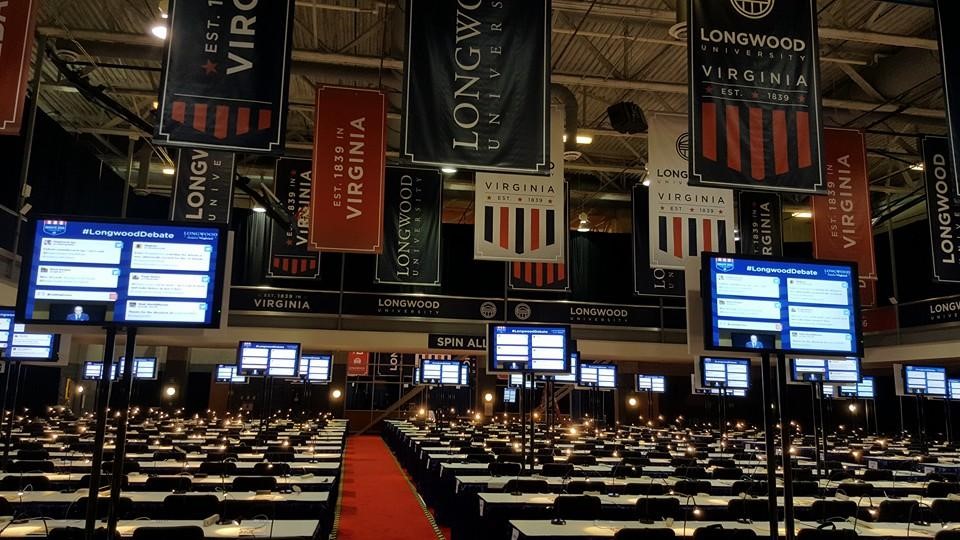Looking for lessons from the presidential election?
Who isn’t, right? :$
 Fortunately for us, Mary Jo Stockton, Director of Web and Social Content at Longwood University and a past presenter of the Higher Ed Content Conference (the call for proposals for this year is now open), wants to share with the lessons learned hosting the VP debate on her campus on October 4, 2016.
Fortunately for us, Mary Jo Stockton, Director of Web and Social Content at Longwood University and a past presenter of the Higher Ed Content Conference (the call for proposals for this year is now open), wants to share with the lessons learned hosting the VP debate on her campus on October 4, 2016.
While the odds of your school hosting a presidential debate in the future are very low, what she learned can help you plan for your next big or high-profile event on your campus.
Debate Effect
What happens when you host one of the four national debates during a presidential general election?
This:
That’s a lot of attention for a mid-sized, liberal arts university in rural Virginia, and it doesn’t happen without developing effective communication strategies across multiple social outlets.
Pre-Debate: Getting Social Media Assets Ready
We began developing marketing strategies long before the debate locations were announced in September 2015. Though we didn’t know if Longwood would be selected as a host site, we needed to be ready to capitalize on the instant spotlight as millions of people asked, “What is Longwood?” and “Where is Farmville?”
On the day of the announcement, we were fully prepared with assets to share on social media that would resonate with our core audience and inspire them to share the news.
This post was shared 2,030 times on Facebook (more than 40 times our average) and resulted in more than 70 times our average engagement on Twitter.
In the days following the announcement, we shared:
- content to build on the pride our community was feeling
- a selection of articles coming from news media about the announcement
- content we produced to inform our audience what this meant for Longwood
A similar strategy was continued throughout the year, balancing social media posts and press releases tied to the debate with our more usual content. The debate was woven into events and class curricula across campus, and we created content to highlight these efforts. We also provided information to our community about what was being done to prepare for the event and what to expect at the time of the debate.
Debate Week: People & Tools for Social Media
When debate week arrived, it was an opportunity to play with some social media platforms and services that we had not yet touched.
Our goals were to:
- include members of the Longwood community that could not make it to campus for the excitement
- provide the final push to anyone undecided about coming to campus
- capture the reactions across campus, our community and the media through curation of social media posts
With a team of volunteers comprising mostly current students, we used Tweetdeck, Hootsuite, Tagboard and Instawall (a tool from Instagram/Facebook) to watch for and curate content to be viewed by all. The primary tool used for sharing was Tagboard, which we displayed on a big screen in the main campus viewing area and in other campus locations such as in the media center. We also embedded the tagboard on the Longwood homepage and our debate website.


Three social media teams were assigned iPod Touch devices and roamed campus creating content for Snapchat, Facebook Live, Instagram Story and Periscope. Facebook Live and Periscope tours of campus were broadcast on the day of the debate. In the evening, a tour of the media center and Spin Alley pre-debate and a view of Spin Alley post-debate gave our community exclusive rare access to these aspects of the debate. Although they were in no way polished, the raw, live broadcasts were immensely popular.
Utilizing an editorial calendar, social media posts were planned in advance to make sure interesting content was shared regularly. We shared albums every day in the lead-up to and during the debate, along with stories to enrich the experience of what was happening on campus. In between the planned posts, we made sure to allow for unplanned golden moments—such as our mascot, Elwood, appearing live on the MSNBC stage. That moment yielded the second-highest engagement of any Longwood Instagram post EVER.
We also made use of 360 video for the first time using a 360fly device, and, while the quality wasn’t what we hoped, it was very simple to accomplish and proved popular with our audience on Facebook.
So, was it worth it?
The chart at the beginning of this article provides part of the answer. We also saw dramatic increases for some of our social media platforms when comparing fall 2016 metrics to fall 2015.

These increases are even more impressive when the increase in fall 2015 numbers due to the September debate announcement is taken into consideration. So the semester-over-semester increase due to the debate is actually greater than these numbers indicate.
In addition, three of our top 10 most-engaging Facebook posts and seven of our top 10 most-engaging Instagram posts EVER are debate-related. And our top three most-engaging tweets are ALL debate-related.
Takeaways
We plan to build on some of the discovery we did during this process, especially with live social media content. We’ve already live streamed a few more events and have also utilized 360 video since the debate. All have been very popular.
We are also looking at additional ways to use this technology to make our audiences more aware of opportunities available to our students. For example, two students gained an internship with Fox News during this year’s Super Bowl in Houston, and we’re sending one of the iPod touch devices with them so they can share the experience via Snapchat and Instagram Story.
Discovering Tagboard was another debate win, and we continue to use it on our homepage to share the great social media posts from the Longwood community.
Final thought: Not every campus gets to host an event of this magnitude, but, if a similar opportunity does come along, it’s worth exploring every avenue available to make the most of it.
Got Higher Ed Content Tales to Tell?
Submit a 10-min session proposal for the 2017 Higher Ed Content Conference




